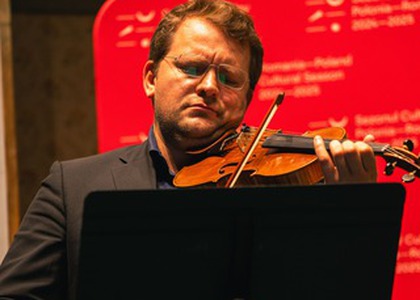> Interviews

Interview with violinist Valeriy Sokolov
Violinist Valeriy Sokolov will perform a recital alongside pianist Maria Diana Petrache on Wednesday, October 15th, 2025, at the Romanian Athenaeum. The evening's program highlights the works of two celebrated composers this year, Maurice Ravel and George Enescu. The Ukrainian musician spoke about the program, as well as his relationship with Romania and the Romanian audience, in an interview with Ana Sireteanu.
Twenty years ago, you won the Enescu Competition, with 2005 marking the beginning of a long relationship with Romania. How do you remember that experience from the perspective of the artist you are today, and how would you describe the importance of this achievement in your career?
It was one of the most important moments of my life, in general, and since then, Romania has become a very important country for me-not only because of Enescu's artistic personality, but also thanks to this competition and the musical life I have experienced in Romania from 2005 until now. During this time, I have returned almost every year to perform on various stages in your country. Additionally, I have met many Romanian musicians over the years who have shown me the cultural richness of Romania, as well as the love of both audiences and artists for classical music. So, all of this combined has been a very important experience for me, one that has truly changed my life.
You are performing a recital at the Bucharest Philharmonic that celebrates both Maurice Ravel and George Enescu, a program you also presented in Sinaia during the 2025 edition of the Enescu Festival. On this occasion, you are resuming your collaboration with pianist Maria Diana Petrache. How would you describe your artistic relationship with her?
Our collaboration began some time ago, in 2022, so we are now in our fourth year of performing together. We have already given recitals in Sinaia, as you mentioned, and in Târgu-Mureș. I also invited Maria Diana to perform with me in Western Europe, and later she invited me back to Romania to perform recitals together. So, we are stage partners and good friends. I can say that she is one of the brightest Romanian pianists of her generation. Beyond her remarkable intelligence and technique, she also brings a Western perspective due to her studies in Hanover. I would say she is the heir to the generation of Romanian female pianists so well known and appreciated today, who have influenced both Western European and Eastern European piano schools. Thus, I believe she can continue this tradition of female pianism.
What does Enescu's music mean to you?
Music cannot be separated from his personality. What impresses me is the breadth of his character, always perfectly combined with his introverted and modest nature, his human qualities, and his musical genius. He is also an example on a human level-a person who never forgot his roots. To all this, add his exceptional sensitivity, so that his music is the result of this incredible personality. Speaking of the Third Sonata, it is remarkable how he incorporated folk-lăutar music into a classical music piece, a very successful experiment. I am one of those deeply moved by Enescu's personality, and even seven decades after his passing, he is still very present in our consciousness. I am probably one of thousands of people who are emotionally touched by his music. Not to mention the Festival bearing his name, one of the most extensive series of events, which further demonstrates the magnitude of his personality.
It is known that Ravel and Enescu were colleagues at the Paris Conservatory. How do you view their styles and the combination of their music? Do you see a connection between Ravel's Tzigane and Enescu's Third Sonata?
The whole story of composers influenced by fiddlers' music is already a topic in itself. Whether we talk about Brahms, Ravel, or Enescu, who was not only influenced, but had the lăutar spirit in his violin playing and music. So we can say he was naturally influenced by this tradition from childhood. All composers who turned to lăutar music always tried to understand this phenomenon of a person who takes the violin in hand and, through music, projects their thoughts beyond themselves, reflecting the turbulent fate of the Romani people, first captured by Spain and then by other distant lands.
In Ravel's case, his imagination went beyond his style; Tzigane expresses a cultural mix of French, Spanish, and other distant musical influences he encountered at the International Exhibition in Paris. In Sarasate or Brahms, we see other facets of this theme, while in Enescu it is unique. He gives this music multiple dimensions, adding his creative depth. Enescu did not borrow just specific melodies or rhythms; he went further, understanding the structure of this music. It is incredible how he conveys the improvisation of a fiddler while preserving the honesty of Eastern European music and the modesty that characterizes him. In this work, one does not feel the imprint of the composer, which I believe illustrates this tradition most authentically. Of course, Ravel also captured the colors of this music, but Enescu brought out even more facets of this influence. Therefore, I would say Enescu is the winner in this "competition" of translating lăutar music into classical composition.
You have returned often to Romania to perform at the Enescu Festival. How would you describe your interaction with the Romanian audience?
I think it is a very cultivated audience that appreciates good music, and the Enescu Festival represents what Romania is today: a country eager to learn about the best trends abroad while filtering them through its own traditions. The business side has not yet stifled Romania's cultural sphere, and I hope it never will. The audience in Romania is very genuine!
Translated by Ruxandra Ioana Șerban,
University of Bucharest, Faculty of Foreign Languages and Literatures, MTTLC, year I
Corrected by Silvia Petrescu














